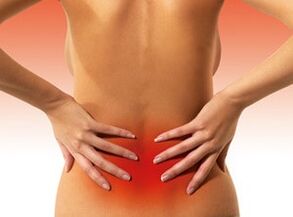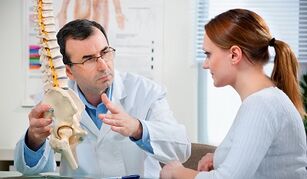
If a person experiences pain in the spine, the symptoms indicate irritation of the nerve endings. Degenerative-dystrophic lesions often develop between the vertebrae, which compress muscles, blood vessels and fibers of the NS. If a patient has a backache in the lumbar region, a neuropathologist, vertebrologist and chiropractor will help determine the causes and treatment.
There are several main factors that influence the appearance of discomfort in the lumbar zone. These include:
- Any kind of curvature of the spine;
- Hypothermia of the back, legs;
- Overload of muscle tissues (lifting weights, working in the same position);
- Insufficient physical fitness of the musculoskeletal system;
- Lack of vitamins, malnutrition;
- Overweight;
- Smoking, alcohol abuse and other bad habits.
Pain in the lumbar region is the most common complaint of patients visiting doctors. According to statistics, approximately 70% of all people who have reached their 30s already face such problems. Since the lumbar region is located under the thoracic and above the sacral region, the central zone of the spine takes on the maximum loads.
Pain can be of a different nature. It depends on the reason for the appearance. Painful sensations are described as aching, burning, cutting, sharp, blurry. Sometimes the pain spreads to other parts of the back and even to the lower limbs. It comes on gradually or suddenly. There are unbearable pains, but often it also depends on the psycho-emotional state and age-related changes.
There are the following types of lower back pain:
- Lumbago- characterized as a sharp lumbago (appears as a result of hypothermia or physical overload);
- Lumbodynia- characterized by aching pains of a chronic nature (people often experience from sedentary activity);
- Lumboischialgia- is determined by the spread of pain to the legs (often a sign of a hernia).
CT or MRI is used to diagnose the cause of spinal discomfort. Sometimes it is enough to make an x-ray of the affected area of inflammation. Also, doctors make a diagnosis based on complaints and an external examination of the patient's body.
Causes of back pain in the lumbar region: common pathologies

Basically, uncomfortable sensations are manifested due to pathologies of the lumbar spine. If they appear, then you should definitely see a specialist and not allow the disease to progress. Osteochondrosis, hernia, protrusion often become the cause of pain. All of them are characterized by an increase in symptoms during movements, body turns, and bends.
Much less often, the causes of back pain in the lumbar region are more serious and even life threatening. For example, there are disorders of the lumbar spine due to metastasis of cancerous growths, infections of the vertebrae, internal organs, metabolic disorders in bone and muscle tissues, and fractures.
Studies have shown that 90% of low back pains are associated with myofascial disorders, that is, with the tightening or overload of the muscles surrounding the vertebrae. And only 10% are pathologies that are caused by true vertebrogenic changes. It has been proven that the formation of osteochondrosis is associated with early displacement of the vertebrae.
The most common causes of pain are:
- Injuries;
- Stretching of muscles, ligaments;
- Displacement of the vertebrae;
- Compression of nerve endings due to hernia, osteochondrosis, stenosis;
- Fractures, deformities of the spine;
- Pregnancy.
Much less often pain occurs after an infectious lesion, spondylitis, deformational changes, and diseases of the abdominal organs.
If pain persists for more than three days, see a doctor. Since most often discomfort is felt against the background of overloading of the spinal muscles, the problem can be corrected in a short time with the right choice of treatment methods.
Back pain in the lumbar region on the left: what is behind them?
If a person has discomfort or severe pain in the lower part of the lumbar spine, then, most likely, the cause of this phenomenon is irritation of nerve fibers, tense muscles or irradiation of a symptom of the affected internal organ. But mainly back pain in the lumbar region on the left develops through disorders of the functions of the musculoskeletal system.
In terms of frequency, soreness on both sides of the spine occurs in approximately the same percentage. But patients usually turn to a specialist even when the diseases are neglected and require long-term treatment.
If the pain radiates to the left side, then, as a rule, it is provoked by inflammation of the internal organs. The left-sided lumbar zone projects diseases of the kidneys, intestines, stomach, pancreas, ovary. If the disease is acute, then it is accompanied not only by the spread of pain to the left side of the lumbosacral region, but also by fever, discomfort in the abdominal cavity, defecation or urination disorders, and menstrual irregularities.
Women who complain of lower back pain should be seen by a gynecologist. If the problem occurs in men, then to the urologist. It is imperative that you be examined by a therapist, do ultrasound of organs, and take tests. If no abnormalities are detected during the diagnosis, then a spinal examination is prescribed. The most reliable method is MRI, which helps determine the cause of the back pain on the left.
By the spread of pain, it is possible to determine which part of the lumbar spine is affected and what will be the consequences of the pathology.

- If painful sensations on the left side of the lower back pass to the lower limb or gluteus muscle, then the nerve roots of the lower part of the section are affected. Distant pains indicate a neglected disease that affects the entire root.
- When soreness radiates to the groin or abdomen, then the pathology is in the upper part of the lumbar vertebrae.
- If distant pain affects the appearance of numbness in the limbs, then over time, such a violation can cause paralysis.
- If discomfort spreads to the leg while walking, there is a possibility that the sciatic nerve is inflamed.
An accurate diagnosis will be made by a specialist who will direct the patient to all the necessary research methods.
How to treat lower back pain? Effective methods
After the diagnosis, doctors will prescribe medications or physical procedures that will help eliminate the symptoms of pathology caused by disorders in the lumbosacral region. The exact prescriptions depend on the true cause of the pain. Consider the most basic methods of treating the symptoms of various diseases or pathologies.
Ointments
This type of medicine is effective primarily because it can be used at home without the help of other people. The ointment relieves local inflammation caused by sprains or compression of nerve roots. It also warms up muscle tissue if pain occurs due to hypothermia of the back.
There are several types of ointments:
- Anti-inflammatory analgesics,which relieve irritation, soreness and have a cooling effect.
- Combined funds, used for back injuries. They can have healing, analgesic, cooling, anti-inflammatory effects.
- Irritant drugs,aimed at vasodilation in the affected area to improve blood flow.
- Chondroprotectorsare used to treat pathologies of cartilage tissue.
How to treat low back pain, only a doctor can tell. What type of ointment should be used, the specialist will determine only after the diagnosis of the spine.
Injections
With the help of injections, pain in the lower back can be relieved in a very short time. Intramuscular or intravenous solutions are more effective than oral drugs, because they bypass the gastrointestinal tract and enter the bloodstream directly to the site of the inflammatory process. But giving injections to oneself is not always convenient, so the patient will have to visit the clinic every day or call the medical staff at home. Almost all low back injections are available with a prescription.
Warming up
This method of therapy is more related to folk recipes and is used only for non-inflammatory pain in the back. It is used for osteochondrosis, hernia, muscle strain, curvature of the spine. If the pain is caused by an infectious lesion, then warming up will only intensify the symptoms and worsen the patient's health. To achieve a positive effect, apply dry heating pads or hot compresses up to 10 times a day.
Physiotherapy exercises
Should be appointed by a physical therapist who, after diagnosing the cause of low back pain, will be able to select optimal exercises. The goal of these exercises is to strengthen the muscles in the back to correct posture and reduce soreness during physical activity.
Massage
Well relieves pain in the lumbar spine, but should only be done by an experienced specialist. With the help of effective massage movements, it is possible to improve blood circulation in the area of the affected area and make the muscles more elastic and flexible. Massage relieves acute pain, removes toxic substances from cells, and stimulates nerve endings. It is good to combine massage treatments with a visit to the sauna.




























